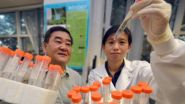(Press-News.org) AUGUSTA, Ga. – A small protein named GILZ appears to protect against the bone loss that often accompanies arthritis and its treatment, researchers report.
Arthritis as well as aging prompt the body to make more fat than bone, and the researchers have previously shown GILZ can restore a more youthful, healthy mix. It also tamps down inflammation, a major factor in arthritis.
Now they have early evidence that GILZ might one day be a better treatment option for arthritis patients than widely used synthetic glucocorticoids, which actually increase bone loss, said Dr. Xingming Shi, bone biologist at the Medical College of Georgia at Georgia Regents University.
Their research is being presented at The American Society for Bone and Mineral Research 2014 Annual Meeting Sept. 12-15 in Houston.
In addition to bone loss, glucocorticoids, such as prednisone, produce other side effects, including diabetes. While GILZ is induced by glucocorticoids, directly overexpressing the protein appears to better target sources of bone loss and inflammation and avoid these serious side effects. .
For this study, the focus was tumor necrosis factor alpha, a proinflammatory cytokine that helps regulate immune cells and is a major player in arthritis. Tumor necrosis factor alpha primarily works though promoting inflammation, which is great if the target is cancer. However, when tumor necrosis factor alpha becomes dysregulated, it can also cause diseases like arthritis and inflammatory bowel disease.
To look specifically at the impact on bone loss, the researchers crossed mice bred to overexpress tumor necrosis factor alpha throughout the body with mice that overexpressed GILZ in just their mesenchymal stem cells. These stem cells produce the osteoblasts, which make bone. They also make fat, and when the cells stop making as much bone, they tend to make more of it. Shi's lab has shown that GILZ can coax mesenchymal stem cells back to making more bone and less fat.
While the mice that overexpressed only tumor necrosis factor alpha quickly developed arthritis along with significant bone and weight loss, those that also overexpressed GILZ had significantly less bone loss, Shi said.
"Our previous studies have shown that the GILZ transgenic mouse can make more bone," said Dr. Nianlan Yang, MCG postdoctoral fellow. "We wanted to see if GILZ would still have a bone protective effect in an inflammatory environment similar to arthritis."
Next steps include developing an oral medication, a peptide specifically, that increases GILZ expression rather than the genetic alterations the researchers have used in animal models, said Yang. She just completed a National Arthritis Foundation fellowship, which helped support that effort. They also want to see if GILZ can prevent arthritis from developing in the face of inflammation.
Glucocorticoids and GILZ are both produced naturally in the body. Glucocorticoids are steroid hormones that help regulate the body's use of the fuel glucose and dampen the immune response.
INFORMATION:
Toni Baker
Communications Director
Medical College of Georgia
Georgia Regents University
706-721-4421 Office
706-825-6473 Cell
tbaker@gru.edu
Protein appears to protect against bone loss in arthritis
2014-09-12
ELSE PRESS RELEASES FROM THIS DATE:
Dendritic cells affect onset and progress of psoriasis
2014-09-12
Different types of dendritic cells in human skin have assorted functions in the early and more advanced stages of psoriasis report researchers in the journal EMBO Molecular Medicine. The scientists suggest that new strategies to regulate the composition of dendritic cells in psoriatic skin lesions might represent an approach for the future treatment of the disease.
"We urgently need new ways to treat psoriasis, treatments that will deliver improved benefits to patients and reduce the incidence of known side effects for existing drugs," says EMBO Member Maria Sibilia, ...
Gray matter matters when measuring our tolerance of risk
2014-09-12
There is a link between our brain structure and our tolerance of risk, new research suggests.
Dr Agnieszka Tymula, an economist at the University of Sydney, is one of the lead authors of a new study that identifies what might be considered the first stable 'biomarker' for financial risk-attitudes.
Using a whole-brain analysis, Dr Tymula and international collaborators found that the grey matter volume of a region in the right posterior parietal cortex was significantly predictive of individual risk attitudes. Men and women with higher grey matter volume in this region ...
Age and diabetes duration linked to risk of death and macrovascular complications
2014-09-12
New research published in Diabetologia (the journal of the European Association for the Study of Diabetes) shows that age (or age at diagnosis) and duration of diabetes disease are linked to the risk of death and marcovascular complications (those in larger blood vessels), whereas only diabetes duration is linked to the risk of microvascular complications (in smaller blood vessels such as those in the eyes). This means younger people with diabetes are more at risk of microvascular complications since they are more likely to have diabetes for longer over their lifetimes ...
The Lancet: Combining gut hormone with insulin proves more effective at controlling type 2 diabetes than other common treatments
2014-09-12
Combined treatment with a drug that mimics the action of a gut hormone and basal insulin [1] is more effective at improving blood sugar control than other anti-diabetic treatments, with similar rates of hypoglycaemia (dangerously low blood sugar levels) and greater weight loss, a systematic review and meta-analysis published in The Lancet shows.
"Achieving normal blood sugar levels in people with type 2 diabetes is compromised by the adverse side effects plaguing currently available treatments. Some anti-diabetic treatments increase risk of hypoglycaemia and weight gain ...
Many kidney failure patients have concerns about pursuing kidney transplantation
2014-09-12
Washington, DC (September 11, 2014) — Concerns about pursuing kidney transplantation are highly prevalent among kidney failure patients, particularly older adults and women, according to a study appearing in an upcoming issue of the Clinical Journal of the American Society of Nephrology (CJASN). Reducing these concerns may help decrease disparities in access to transplantation.
There are thousands of patients with kidney failure who lack access to kidney transplantation, and disparities persist in terms of race, age, sex, and other patient characteristics. To improve ...
Microbes evolve faster than ocean can disperse them
2014-09-12
Two Northeastern University researchers and their international colleagues have created an advanced model aimed at exploring the role of neutral evolution in the biogeographic distribution of ocean microbes.
Their findings were published Thursday in the journal Science. The paper—titled "Biogeographic patterns in ocean microbes emerge in a neutral agent-based model"—was co-authored by Ferdi Hellweger, a microbial ecology expert and an associate professor of civil and environmental engineering; his doctoral student Neil Fredrick, PhD'15; and oceanographer Erik van Sebille ...
Inflammation may be key to diabetes/heart disease link
2014-09-11
Inflammation may be the reason high blood sugar levels damage blood vessels, raising the possibility that anti-inflammatory medications might someday be used to lower the risk of blood vessel disease in people with diabetes, according to a study presented at the American Heart Association's High Blood Pressure Research Scientific Sessions 2014.
"These findings may explain why good blood sugar control is not sufficient to avoid the development of diabetes-induced cardiovascular diseases," said Carlos F. Sánchez-Ferrer, M.D., Ph.D., study author and professor of pharmacology ...
Cutting the cord on soft robots
2014-09-11
When it comes to the development of soft robots, researchers have finally managed to cut the cord.
Engineers at Harvard's School for Engineering and Applied Sciences and the Wyss Institute for Biologically Inspired Engineering have developed the world's first untethered soft robot – a quadruped which can literally stand up and walk away from its designers.
Working in the lab of Charles River Professor of Engineering and Applied Sciences Robert Wood, a team of researchers that included Michael Tolley, Robert Shepherd, Bobak Mosadegh, Kevin Galloway, Michael Wehner ...
NASA research helps unravel mysteries of the Venusian atmosphere
2014-09-11
VIDEO:
New research shows giant holes in Venus' atmosphere -- which serve as extra clues for understanding this planet so different from our own.
Click here for more information.
Underscoring the vast differences between Earth and its neighbor Venus, new research shows a glimpse of giant holes in the electrically charged layer of the Venusian atmosphere, called the ionosphere. The observations point to a more complicated magnetic environment than previously thought – which ...
Tipping the balance of behavior
2014-09-11
Humans with autism often show a reduced frequency of social interactions and an increased tendency to engage in repetitive solitary behaviors. Autism has also been linked to dysfunction of the amygdala, a brain structure involved in processing emotions. Now Caltech researchers have discovered antagonistic neuron populations in the mouse amygdala that control whether the animal engages in social behaviors or asocial repetitive self-grooming. This discovery may have implications for understanding neural circuit dysfunctions that underlie autism in humans.
This discovery, ...



